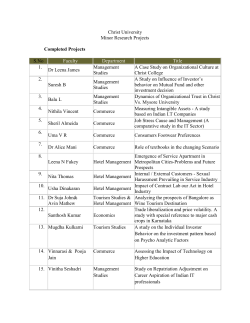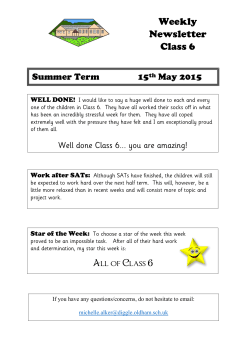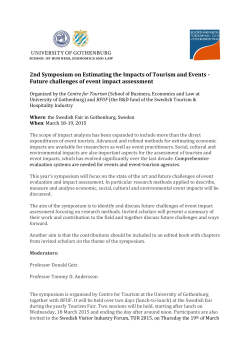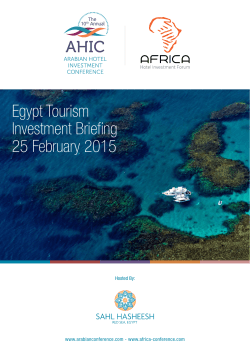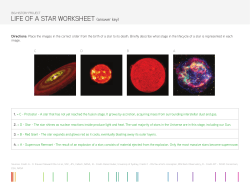
Factors Affecting Customer Ratings of Indian Hotels
Proceedings of the International Symposium on Emerging Trends in Social Science Research (IS15Chennai Symposium) ISBN: 978-1-941505-23-6 Chennai-India, 3-5 April 2015 Paper ID: C531 Factors Affecting Customer Ratings of Indian Hotels Aswin. K, MBA Student, Amrita School of Business, Amrita Vishwa Vidyapeetham, Coimbatore, India. Sangeetha Gunasekar, Faculty, Amrita School of Business, Amrita Vishwa Vidyapeetham, Coimbatore, India. ___________________________________________________________________________________ Abstract Role of social media in Tourism is one of the major players and the online travel market has assumed a consistent size. In Europei, it represents (in 2007) almost 19.4% of the total market. According to an Ernst & Young studyii in 2014, Indian organizations use social media more than the global average implying a growing potential for social media marketing in India in the field of Tourism and Hospitality. User reviews and comments on hotels on the web are an important information source in travel planning. Popular social media website TripAdvisor.com allows customers to rate their experience on different parameters and also allows writing their reviews. Since the ratings and reviews in TripAdvisor.com are globally accepted and also other Indian travel websites use Trip Advisor for their reviews, Indian hotels are keen towards improving their ratings in the same website. Our study tries to explore the factors affecting the customer ratings of Indian hotels, particularly in Goa. ___________________________________________________________________________ Key words: Tourism, Indian Hotels, Social Media Marketing, Trip Advisor, Customer Ratings. 1 www.globalbizresearch.org Proceedings of the International Symposium on Emerging Trends in Social Science Research (IS15Chennai Symposium) ISBN: 978-1-941505-23-6 Chennai-India, 3-5 April 2015 Paper ID: C531 1. Introduction Travelling and tourism has been an integral part of Indian culture and tradition. India’s alluring beaches, historical monuments, serene backwaters, foggy hill stations, pilgrimage sites and the traditional Indian hospitality capture the heart and soul of the tourists across the globe and they have been irresistibly attracted to India.iii The great influx of foreign tourists into the country made tourism and hospitality a key sector of the Indian economy accounting for round 12.4% of the total employment in India. India is a fast growing market and sees a positive growth with respect to occupancy in hotels.iv The Indian hoteliers are very optimistic and tourist inflow is expected to increase in future. The Indian state Goa located in the West India region of the Konkan, is famous for its beaches and places of worship, and tourism is its primary industry. In 2011 Goa handled 7% of all foreign tourist arrivals in the country. Coastal areas of Goa attract foreign tourists in winter while summer and winter see a large number of domestic tourists.v Tourism on Internet has assumed a consistent market size in the past two decades and various studies are happening across the globe on the opportunities of online travel and tourism, various technologies used and its impact on the tourism and hospitality industry. In 2008 J. Miguéns et al studied the impact of social media presence in selecting the tourist destinations and hotels, taking TripAdvisor.com as a platform, for the Portuguese city Lisbon. They found that the Trip Advisor ratings of these hotels follow closely the traditional star classification. They also found that if the social network websites will continue their growth as predicted, tourism related topics in social media will be of central importance of travel planning. Tomas Escobar-Rodriguez and Elena Carvajal-Trujillo in 2013 evaluated Spanish hotel websites in terms of their informational and relational strategies. They analysed the relationship between the size of the hotel and website strategy. The study done by Xiang and Gretzel in 2010, investigated the extent to which social media appear in search engine results in the context of travel-related searches. This study confirms the growing importance of social media in the online tourism domain and also discusses the challenges faced by travel-related information providers and implications of tourism marketers in terms of online marketing strategies. Recently, Lingqiang Zhou et al (2014) studied the user generated content in online hotel reviews and its relationship with the customer satisfaction for an emerging Chinese tourist destination, Hangzhou, by analysing over a thousand user-generated reviews about five star and four star hotels that were posted on Agoda.com. According to 2014 statistics shared by the Ministry of External Affairs, Government of India, the Indian hospitality sector has been growing at a cumulative annual growth rate of 14 per cent every year, adding significant amounts of foreign exchange to the economy. vi On the other hand Indian social media is growing at a rate more than the global average. But there is 2 www.globalbizresearch.org Proceedings of the International Symposium on Emerging Trends in Social Science Research (IS15Chennai Symposium) ISBN: 978-1-941505-23-6 Chennai-India, 3-5 April 2015 Paper ID: C531 not much study happened in India connecting the wonderful opportunities of Tourism and Social media. Here, aim of our study is to investigate the factors affecting the customer ratings of Indian hotels in the social media website TripAdvisor.com, taking Goa as the research context. We have collected 842 customer reviews across 18 star hotels from Goa for our study. The results of the study indicate that service is the most important factor that influences the customer’s overall experience followed by the room quality. 2. Research Methodology 2.1 Research Context Goa, popularly known as the ‘pearl of the orient’, is one of the most delightful places in India. Because of its tropical climate, Goa is a tourist’s destination for all the seasons. Formerly a Portuguese colony, which is still having a unique cultural synthesis of the east and the west, attracts large number of foreign travellers every year. The number of foreign tourist arrivals for Goa in 2013 was approximately 5 Lakhs, almost 10% higher than the previous year, which is far ahead of the national growth rate of 5.9%.vii For our study we chose Goa as the research context. According to the official website of Ministry of Tourism, Govt of India, there are 39 star hotels in Goa. It includes 14 five-star deluxe, 8 five-star, 3 four-star and 14 three-star hotels. The amenities across the star hotels vary based on the star rating. While 5 star deluxe, 5 star and 4 start hotels are comparable in most amenities, 3 star hotels differ in several of them like service and amenities available to consumers. To make the sample comparable, the scope of our study is limited to the four-star and five-star hotels in Goa. We are using TripAdvisor.com as a platform for collecting customer ratings and reviews because it is one of the most popular travel research websites in the world, owned by Trip Advisor Inc. It has its operations in 34 countries including USA and China. In addition to the flagship Trip Advisor brand, it manages and operates under 21 other travel media brands.viii Many Indian travel websites, like Yatra.com and MakeMyTrip.com, also use TripAdvisor.com for the reviews and ratings of hotels and restaurants. Its travel research platform features reviews and opinions from its community of travellers about travel destinations, hotels, restaurants and activities. In case of hotels, TripAdvisor.com allows the customer to rate the overall experience and the individual attributes. The different individual attributes include sleep quality, location, room quality, service, value for money and cleanliness. The customer can rate his experience on a scale of five, 5 being excellent and 1 being terrible. Information on the type of the respondent is also available for most of the reviews indicating whether the respondent has visited the hotel on business purpose, with family, with friends, as a couple or alone classified 3 www.globalbizresearch.org Proceedings of the International Symposium on Emerging Trends in Social Science Research (IS15Chennai Symposium) ISBN: 978-1-941505-23-6 Chennai-India, 3-5 April 2015 Paper ID: C531 as business, family, friends, couple or solo. Our analysis uses this information along with the attributes to understand the customers rating of hotel experience. 3. Data Description 3.1 Description based on type of respondent and the type of hotel. From TripAdvisor.com, all the customer ratings across the 18 five star deluxe, five star and four star hotels in Goa were taken for the year 2014, restricted to the months of October to January. A total of 842 customer ratings were collected for the study across 18 five star deluxe, five star and four star hotels in Goa from TripAdvisor.com. Of these 842 ratings, information regarding the type of the respondents is not available for 94 ratings. For 127 reviews only overall experience is rated with none of the attributes being rated. Hence for these observations it is not possible to understand which of the attributes were important for consumers in rating the hotels. Our study excludes these observations. In all we have a total 621 observations where overall hotel rating was given by the consumer and at least one of the attributes were rated along with information on the type of customer. The distribution of these ratings across various respondent types and hotel categories are given below in figures 1 &2 respectively. Fig1. Distribution of Customer Ratings Across Respondent Types Family Business Friends Solo Couple Fig2.Disribution of Customer Reviews Across Hotel Categories 4 Star 4% 5 Star 5 Star Deluxe 12% 12% 42% 41% 29% 47% 13% Of the 621 respondents the highest percentage of customers who had visited the hotel were accompanied by family, which approximated to 42 per cent, with couples being the second highest customer type comprising of 29 per cent in all respondents. Customers accompanied by friends and on business trips approximated to 12 and 13 per cent respectively while the lowest proportion of respondents who rated the hotels belonged to solo group, which approximated to 4 per cent of total respondents. Among the hotels considered for our study, approximately 88 per cent of observations on ratings came from five star hotels and five star deluxe hotels with individual percentages at 4 www.globalbizresearch.org Proceedings of the International Symposium on Emerging Trends in Social Science Research (IS15Chennai Symposium) ISBN: 978-1-941505-23-6 Chennai-India, 3-5 April 2015 Paper ID: C531 approximately 47 per cent and 41 per cent respectively. The remaining 12 per cent of observations came from four star hotels. 3.2 Description based on overall hotel ratings: The proportion of customer ratings according to their overall experience is depicted in figure 3. Of the 621 reviews, for which overall experience and at least one attribute is rated, 51% of the respondents rated the overall experience as excellent, followed by 32% as very good, 12% as average and about 5 per cent respondents rated the experience as poor or terrible (approximately 3 per cent for poor and 2 per cent for terrible ratings) . Fig3. Overall Experince Rating by Respondents Terrible Poor Average Very Good Excellent 2%3% 12% 51% 32% Further details of ratings for the six individual attributes for each hotel across the 621 respondents are given in figure 4. Of the total number of respondents, ratings of ‘excellent’ and ‘very good’ show the highest percentage for all of the attributes. Fig4. Attributes Rating by Respondents 100% 90% 80% 70% 60% Excellent 50% Very Good 40% Average 30% Poor Terrible 20% 10% 0% Sleep Quality Location Room Quality Service Value for money Cleanliness 5 www.globalbizresearch.org Proceedings of the International Symposium on Emerging Trends in Social Science Research (IS15Chennai Symposium) ISBN: 978-1-941505-23-6 Chennai-India, 3-5 April 2015 Paper ID: C531 4. Empirical Modelling In analysing the impact of different attributes on the overall rating of hotel by customers we estimate ordered logistic regression model. The rational for the choice of the model is driven by our dependent variable, which is the overall hotel rating of the customers. The customers rating of their hotel experience is coded on a scale of 1 to 5 with 5 indicating excellent experience of their stay at the hotel and 1 indicating terrible experience. Values 4, 3 and 2 indicate ‘very good’ experience, ‘average’ experience and ‘poor’ experience respectively. Thus our dependent variable is an ordinal measure variable indicating an orderly categorization of the ratings. Hence our choice of ordered logit model to estimate the probabilistic impact of different attributes on the overall rating of the hotel by customers. The type of the reviewer and the category of the hotel are also introduced in the model to capture the varying impact of the attributes across these two categories of respondents. The model is as follows: 𝒀𝒊𝒕 = 𝜶𝟎 + 𝜷′ 𝑿𝒊𝒕 + 𝜸𝒏𝒕 𝒁𝒏𝒕 + 𝜹𝒎𝒕 𝑾𝒎𝒕 + 𝒖𝒊𝒕 Where, Y- Overall customer rating X- Individual attributes(X1-Sleep Quality, X2-Location, X3-Room quality, X4- Service, X5Value for money and X6- Cleanliness) Z indicates the categorical variables that we include to capture the type of respondent. The variable takes the values ranging from 1 to 5 indicating the 5 different types of respondents. Z takes the value 1 for Family, 2 for Business,3 for Couple, 4 for Friends and 5 for Solo(Z1-Family, Z2- Business, Z3- Couple, Z4- Friends, and Z5- Solo). W indicates the category of hotel to which the review belongs. There are three categories of hotel that are included in our sample data. The variable takes the value 1 for reviews from four start hotels, 2 for reviews from 5 star hotels and 3 for five star deluxe hotels(W1- 4star, W2- 5star, W3-5star deluxe). Two variants of the above model are estimated. 4.1 Model 1 Of the 842 total ratings, the information regarding the type of the respondent is not available for 94 observations and for 127 observations only the overall experience is rated and not even a single individual attribute is rated. Excluding these two types as it does not make any sense as far as our study is concerned, the total observations under our consideration is 621. Of these 621 ratings, 350 respondents have not rated sleep quality, 337 have not rated location, 325 have not rated rooms, and 353 and 354 respondents have not rated value for money and cleanliness respectively. Whereas in case of service, the number respondents who have not rated this particular attribute is just 2. 6 www.globalbizresearch.org Proceedings of the International Symposium on Emerging Trends in Social Science Research (IS15Chennai Symposium) ISBN: 978-1-941505-23-6 Chennai-India, 3-5 April 2015 Paper ID: C531 Assuming the rating when respondents have not rated an attribute as being neutral i.e. the customers see the attributes as irrelevant or they are neutral to the experience based on that attribute, we recode all the values of non-response as neutral where we code this as zero, we have 621 such observations and this is our first model. 4.2 Model 2 In the second model we consider only those observations where respondent have rated all the individual attributes. By doing so we get a balanced cross section data with 52 observations where all the attributes are rated along with the overall experience. The results of both the models are presented in the results section. 5. Results and Discussion Table 1: Estimation results for ordered logit regression for model 1 & 2. Model 1 Model 2 Variables Odds Ratio Odds Ratio Sleep Quality 1.05 2.45 Location 1.01 1.64 Room Quality 1.10** 3.12** Service 6.96*** 3.25** Value for Money 1.08* 1.63 Cleanliness 1.07* 0.76 Category of hotel 0.95 1.51 Respondent type 1.04 1.11 Chi-square value 421.52*** 67.44*** Number of observations 621 52 Note: *; **; *** indicate significance level at 1%, 5% and 10% level respectively. In the first model where we are considering 621 observations, apart from sleep quality and location all the other four attributes are significant. It is very clear from the results that service is having the highest impact indicating that if the rating of service is increased by one unit the probability that the overall rating may increase is almost 7 times. In the second model where we are estimating the balanced cross section of 52 observations the results indicate that the room quality and service are significant at 5 % level of significance. The odds ratios for both the attributes are above 3. If the rating of room quality or service is increased by 1 unit the probability that the respondent will increase the overall rating is more than 3 times. Consistently service is coming out as the most significant factor affecting the overall customer experience. In both the cases, the type of the respondents and the category of the hotel are not significant. 8. Conclusion The research analyzed the role of social media in the tourism and hospitality industry in an Indian context. Specifically, the objective of the study was to identify the factors affecting 7 www.globalbizresearch.org Proceedings of the International Symposium on Emerging Trends in Social Science Research (IS15Chennai Symposium) ISBN: 978-1-941505-23-6 Chennai-India, 3-5 April 2015 Paper ID: C531 the customer reviews in TripAdvisor.com for the star hotels in Goa. For the study 842 customer reviews across the various star hotel categories are collected and analysed using empirical methods. The service provided is coming out as the most significant of the six attributes followed by the room quality. A sentiment analysis of the reviews may provide more meaningful conclusions to the research. The results of the study may provide strategic inputs for the service providers to enhance their customer experience and thereby increasing the occupancy rate and yield more business. References ERNST & YOUNG (2014) Social Media Marketing-India- Trends-Study 2014.Avalable from: www.ey.com/IN/en/Services/Advisory/EY-social-media-marketing-india-trends-study2014. Accessed: February 2015. INDIA BRAND EQUITY FOUNDATION (2015). Tourism and Hospitality Industry in India. Available from: http://www.ibef.org/industry/tourism-hospitality-india.aspx. Accessed: March 2015. INDIA BRAND EQUITY FOUNDATION (2015). Tourism and Hospitality Industry in India. Available from: http://www.ibef.org/industry/tourism-hospitality-india.aspx. Accessed: March 2015. India. Government of Goa - Directorate of Planning Statistics and Evaluation. (2012-13) Economic Survey. J. Miguéns, R. Baggio, and C. Costa, Social media and Tourism Destinations: TripAdvisor Case Study, IASK ATR2008 (Advances in Tourism Research 2008), Aveiro, Portugal, May. 26-28. United States. TripAdvisor.Inc. (2012-13) Form10-K (Annual Report) WIKIPEDIA (2015)Tourism in India. Available from: en.wikipedia.org/wiki/Tourism_in_India. Accessed: March 2015 WIKIPEDIA(2015)Tourism in Goa. Available from: http://en.wikipedia.org/wiki/Tourism_in_Goa . Accessed: March 2015 i Miguéns et al.,(2008) ii www.ey.com/IN/en/Services/Advisory/EY-social-media-marketing-indiatrends-study-2014. iii http://en.wikipedia.org/wiki/Tourism_in_India http://www.ibef.org/industry/tourism-hospitality-india.aspx v http://en.wikipedia.org/wiki/Tourism_in_Goa vi http://www.ibef.org/industry/tourism-hospitality-india.aspx vii India Government of Goa-Directorate of planning Statistics and Evaluation (2012-13) viii TripAdvisor.Inc, Annual Report 2013. iv 8 www.globalbizresearch.org
© Copyright 2025



